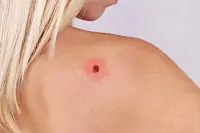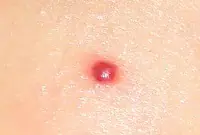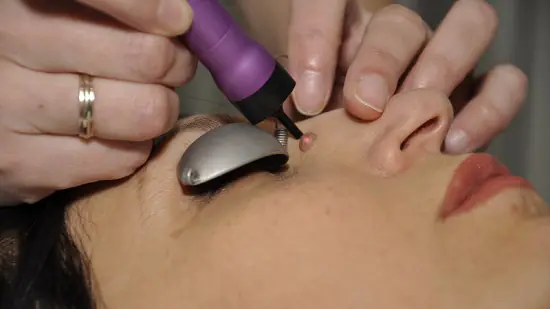Removing a mole requires the work of an experienced specialist and equally attentive aftercare. These two factors can help maintain the health and external aesthetic beauty of the skin. Treatment of the skin area where minor surgery has been performed requires careful handling and the use of only special medications. Depending on how the patient follows the recommendations, the success of the final recovery will depend.
Modern methods allow for high-quality surgery, namely:
- avoid blood loss;
- recover quickly;
- the procedure is quick and painless;
- no scars or scars remain;
- the skin around the operated area is not damaged;
- infection is excluded;
- the mole will not appear again.
After surgery, the patient is advised to refrain from drinking alcohol and prolonged exposure to the sun. Therefore, many doctors do not recommend removing moles in the summer or on the eve of a vacation. This will help prevent the risks of complications after the procedure.
How long does it take for a wound to heal after mole removal?
After removing a mole, much attention is paid to caring for this area of skin. Depending on how to treat the wound after removing a mole, you can speed up or slow down regeneration. Using products not intended for treatment can cause serious harm.
After removal, the wound will recover within 4 to 5 days. The larger the mole, the longer the skin area will take to heal. The healing process can cause considerable discomfort, so many people are concerned about how to speed up the healing of damaged tissue. It is important to know what you should not do during this period:
- apply cosmetics to the area;
- rub with a washcloth;
- peel off the resulting crust;
- allow mechanical damage and excessive friction with clothing.
For faster healing and to prevent complications, you should:
- for treatment, use ointments containing antiseptics and antibiotics;
- when sunbathing in the sun, apply sunscreen;
- refrain from visiting the solarium;
- mild itching can be relieved with any antihistamine ointment;
- follow the instructions of your attending physician.
To quickly get rid of troubles and enjoy the beauty and health of your skin, it is important to follow hygiene and doctor’s advice. In addition, it should be understood that a less experienced or untested specialist can introduce an infection himself. Therefore, it is better to go to an official clinic and see a good doctor.
Doctors' opinions on the most effective methods of treating warts and papillomas
The chief physician of Moscow City Hospital No. 62 describes his vision on this matter. Anatoly Nakhimovich Makhson
Medical practice: more than 40 years.
“I have been treating people’s papillomas and warts for many years. I’m telling you as a doctor, papillomas along with HPV and warts can really lead to serious consequences if they are not dealt with.
The human papillomavirus is present in everyone on whose body there are papillomas, moles, warts and other pigmented formations. According to rough estimates, 80-85% of the planet's population has it. By themselves they are not dangerous. The problem is that an ordinary papilloma can become melanoma at any time.
These are incurable malignant tumors that kill a person in just a few months and from which there is no salvation.
Unfortunately, in Russia and the CIS countries, pharmaceutical corporations sell expensive medications that only relieve symptoms, thereby hooking people on one drug or another. That is why in these countries there is such a high percentage of cancer diseases and so many people suffer from “non-working” drugs.
The only drug that I want to recommend, and it is also officially recommended by WHO for the treatment of papillomas and warts, is Papinol. This drug is the only remedy that has an effect not only on external factors (that is, it removes papillomas), but also acts on the virus itself. At the moment, the manufacturer has managed not only to create a highly effective product, but also to make it accessible to everyone. In addition, within the framework of the federal program, every resident of the Russian Federation and the CIS can receive it for 149 rubles.”
To find out more, read this article.
Wound care after mole removal
Typically, the healing process has several stages. Each of them must use its own methods and care to treat the damaged area. How to care for it and what to apply to the area where the mole was previously depends on the method used for removal. In some situations, the doctor may prescribe rinsing with a weak solution of potassium permanganate or potassium permanganate. These products cannot be used in their pure form; a suitable solution must be made for rinsing. Washing is prescribed already when the wound has become covered with a brown crust.
In the first days, it is not advisable to wet the wound, as well as the crust, which will form a little later. To prevent infections, antimicrobial ointments or those containing an antibiotic may be prescribed to fight infection.
be careful
The presence of papillomas, warts, condylomas, moles and spines on the body is the first sign of malignant melanoma!
We hasten to warn you that most medications “treat” warts, papillomas, moles, etc. - this is a complete deception of marketers who make hundreds of percentage points on drugs whose effectiveness is zero. They do not cure the disease, but only mask the symptoms.
The pharmacy mafia makes huge money by deceiving sick people.
But what to do? How to treat if there is deception everywhere? Doctor of Medical Sciences Anatoly Makhson conducted his own investigation and found a way out of this situation. In this article, the Doctor also told how to 100% protect yourself from melanoma, for only 149 rubles!
Read the article in the official source following the link.
Wound does not heal after mole removal
After the procedure to remove an unwanted mole has been completed, the patient should carefully monitor the further condition of the operated area of the skin. Perhaps the place where the mole was previously is not healing well, is inflamed, or redness around the wound is noticed. All of these are negative symptoms that warrant consultation with your doctor. These signs may mean the following:
- reappearance of a mole;
- entry of bacteria;
- infection during surgery or due to dirt.
Such phenomena should be reported to the doctor and the operated area should be monitored. Of course, if during the healing period a protracted wound becomes wet or the crust falls off early and has not been treated with anything, this may cause the appearance of pus. As a result, the natural recovery process slows down and there is a risk of infection.
Attention! It is important to know that a removed mole can cause the development of a malignant tumor. Therefore, it is important to watch for warning signs.
Wound festers after mole removal
What to do if the wound festers? It is important to treat the wound with antibacterial agents and not restrict air access. If you seal a wound, it will get wet and the infection will multiply.
Serious suppuration is expressed by four main signs, namely:
- increase in the patient's body temperature;
- redness of the area where the operation was performed;
- edema;
- purulent discharge.
Methods aimed at combating microbes will have the fastest healing effect. For example, a drug called Baneocin will be a good remedy in the fight. It can be purchased as an ointment or in powder form. For first aid, you can use those available to everyone at home - brilliant green or potassium permanganate. Both products dry well and destroy the infection, and also minimize local burns.
We invite you to watch a video about the consequences after removing a mole:

Moles are benign growths on the body. They begin to appear from infancy and accompany us throughout our lives. As a rule, they are not dangerous to human health. However, in medical practice there are cases of suppuration of moles. What does this come from? What to do and what first aid to provide? We will answer these and other questions in our article.
Why does pus appear?
In most cases, moles are not dangerous. These are pigmented neoplasms and can be light to dark brown in color. The dimensions do not exceed 5mm. They have a smooth surface and sometimes rise above the skin. Nevi can appear on any part of the skin and at any age.
Why can seemingly harmless tumors fester? Experts identify several factors that may affect this:

— Injury to a mole is the most common cause of inflammation and suppuration. If it is located in places of frequent contact with clothing, or in places where hygiene procedures are performed (shaving, hair removal), then it is possible to accidentally injure or touch the mole. Dirt or germs can get into the wound, which leads to the formation of pus;
— Exposure to ultraviolet rays is the second most popular reason. Many people love to sunbathe and spend time in the sun. The most important thing is to know when to stop and be in direct sunlight only between 8 and 10 am and from 5 to 8 pm, at which time UV rays are no longer so aggressive. If you are constantly in the scorching sun and often get sunburned, this can inevitably lead to inflammation of moles;
- Degeneration into a malignant tumor. Pus can be a harbinger of malignancy of a mole. This can be facilitated not only by external factors, but also by hormonal imbalance, serious illness, or long-term treatment with antibiotics;
- Inflammation of the skin under the mole - this is possible if there is a bacterial or fungal infection of the skin. These are quite specific cases that can be easily diagnosed by a dermatologist during an in-person visit.
First symptoms

If you find similar sensations, then you need to go for a consultation with an oncologist or dermatologist. In this case, self-medication can only do harm. The only thing that experts advise, when it is not possible to quickly seek professional medical help, is that you can reduce inflammation with home remedies. Suitable for this:
- Alcohol tincture or herbal tincture. It can be used to treat a mole and the surrounding skin;
- Lubricate the mole with antibacterial ointment containing salicylic acid;
- Treat with powder from streptocide tablets;
- Apply cotton wool soaked in hydrogen peroxide to the inflamed area for 10 minutes, and then lubricate the mole with a diamond solution to disinfect.
Diagnosis of a festering mole
To accurately diagnose the causes of inflammation of a mole, you must consult a doctor. With a thorough examination, a specialist will be able to determine the nature and cause of the problems with the mole. For a more detailed examination, a biopsy, computer examination or dermatoscopy may be needed.
Only by passing all the necessary tests can you get an objective assessment and understand what actions need to be taken. If the mole is dangerous, the doctor will prescribe removal. If there is no threat to health, and it is not the mole itself that is inflamed, but the skin underneath it, then conservative treatment is possible, using special ointments and solutions.
Mole removal
When prescribing mole removal, the doctor himself selects the most suitable method for this. In modern medicine, several methods are most in demand:
— Surgical excision is the simplest and most well-known removal option. However, today it is least in demand, since it has a number of disadvantages, including:
- long healing of the wound after removal;
- scars remain on the skin;
- the mole is removed, including healthy skin around the neoplasm;
- It is possible that a new mole will appear in place of the removed one.
— Laser therapy is a modern method of getting rid of unwanted tumors on the body. The laser affects only the nevus itself, burning it out layer by layer. This does not harm healthy skin. Some of the main advantages of this method are:
- painlessness;
- bloodlessness;
- speed of the procedure;
- short rehabilitation period;
- the risk of the tumor appearing again is reduced to zero;
- There are no scars or scars left on the skin.
Inflammation of moles during pregnancy is especially dangerous. In this case, the only safe treatment option is laser surgery.

— Electrocoagulation is another modern method of removal. High frequency current is used here. It is most effective for small tumors and can be used in hard-to-reach places. The only significant disadvantage may be a hole or white spot left at the site of mole removal.
You can find out about the best way to remove tumors in our special article “What is better to remove tumors: laser or electrocoagulation?”
What to do after removal?
After removing a mole, it is important to monitor the condition of the skin. There are several simple recommendations that must be followed in the first 2 weeks after the procedure:
- Do not wet the wound;
- If a crust appears at the removal site, do not peel it off; it should fall off on its own;
- When going outside, you need to apply sunscreen to the removal site, if possible, cover it with clothing and not expose it to direct sunlight;
- Do not apply cosmetics to the wound;
- Limit visits to baths, saunas and swimming pools.
Also pay attention to other moles on the body. If they begin to cause suspicion, increase in size or become painful, you should immediately see a doctor.
Healing a mole after removal is a long process and requires careful care. How long it takes depends on the size of the mole: the larger it is, the longer the regeneration process takes. However, the process can be speeded up if the wounds are properly treated after mole removal. To prevent the wound from festering, you should follow simple recommendations. In general, the crusts where the nevus was removed require attention for another 4 weeks.
Wound healing periods after mole removal
After removing moles with a laser, a crust first appears on the skin. Then there is slight swelling and redness. This manifestation is normal 6-8 hours after the procedure. How long the recovery process and healing will last depends on the size of the eliminated nevus. You should begin caring for the affected area of skin immediately after removing a mole with a laser.
First week
After eliminating the nevus, the wound is covered with a crust, which is forbidden to rip off or pick. It performs a protective function against microbes entering the body. You should also protect it from mechanical damage: rubbing, squeezing, shock. During this period, it is not recommended to use cosmetics (decorative and skin care). The crust should be treated with brilliant green, a weak solution of potassium permanganate or an antiseptic ointment prescribed by the doctor. Otherwise it will fester. In order for healing to proceed quickly, you should avoid getting water on the crust. It softens the crust, which facilitates the penetration of microbes into the wound that can provoke an inflammatory process.
Second week
During this period, the crust falls off on its own, leaving a pale pink mark on the skin. At this stage, it is recommended to protect the scar from exposure to sunlight. If the area on the body is open, it is necessary to apply sunscreen with a maximum protection level of at least 60. Otherwise, persistent pigmentation will form on the affected area. It is worth remembering that even in cloudy weather, ultraviolet radiation is 85%.
Third week
At this stage, the skin is completely restored. She is no longer afraid of ultraviolet radiation or mechanical influences. If healing has occurred completely, the affected area no longer requires special care. It may feel itchy. To eliminate it, you can use a soothing ointment recommended by your doctor. In general, tissue regeneration occurs a month after removal of the nevus.
Laser mole removal procedure
Among the methods of mole removal, laser therapy is considered a priority. One session lasts no more than 10 minutes. The nevus is removed layer by layer until a micro-wound appears. In general, several types of lasers are used: erbium, neodymium or CO2 laser. Removal of moles with a laser should only be carried out by a specialist - an oncodermatologist or a dermatocosmetologist. The only discomfort is caused by severe itching after the procedure. The laser method for eliminating nevus has many advantages, including:
- no bleeding;
- speed of the procedure;
- efficiency;
- fast regeneration process;
- the procedure is non-traumatic and painless;
- no scar formation;
- impossibility of infection of the operated skin area;
- the skin areas around the mole being removed are not damaged;
- no reappearance of moles.
Return to contents
Complications
If the operation was performed incorrectly or during the post-rehabilitation period the patient treated the doctor’s recommendations carelessly, then complications are possible. The wound does not heal, turns red and begins to fester. There can be 2 reasons: pathogenic organisms (pseudomonas aeruginosa or staphylococci) entering the wound during surgery or hematogenously (if there is a chronic inflammatory process in the body). Microbes can also enter the wound from the external environment if the patient does not follow hygiene rules or with dirty water.
The fact that the removed mole has festered is indicated by 4 symptoms, which manifest themselves in an increase in temperature, the removal site turns red, swelling appears, and pus is released. In such cases, antimicrobial therapy is prescribed. For example, Baneocin powder or ointment will help heal the removal of a mole. For healing, brilliant green or potassium permanganate are also used. In any case, if the place festers, additional consultation with a doctor is necessary.



